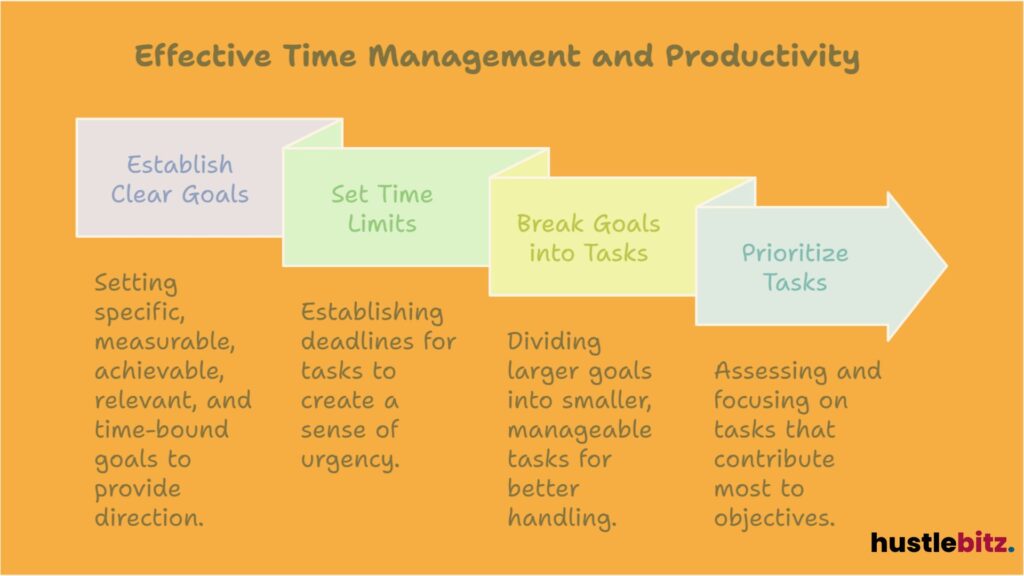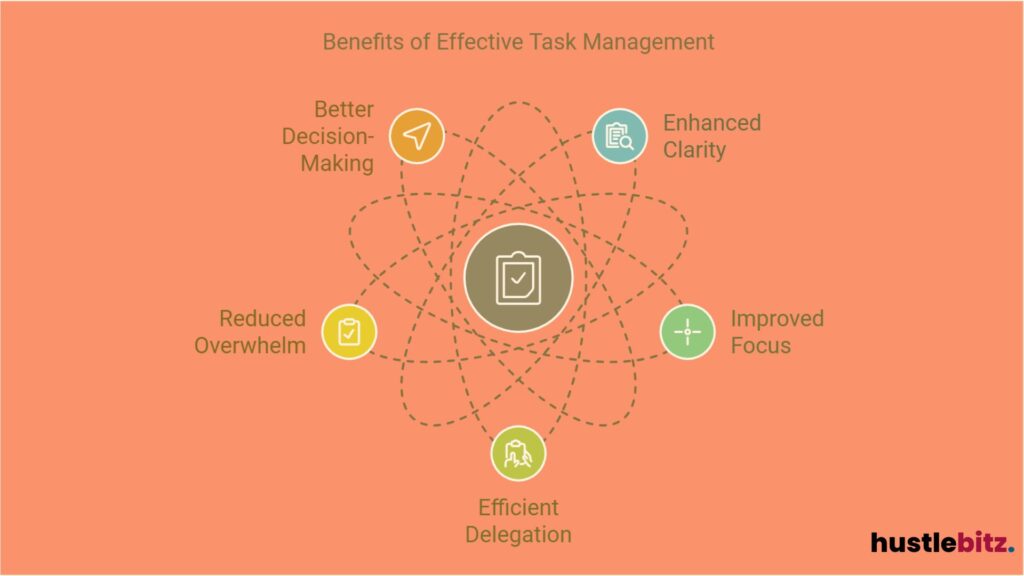Effective time management techniques significantly boost efficiency. Begin by prioritizing tasks using methods like the Eisenhower Matrix, which distinguishes between urgent and important activities. Setting SMART goals provides clarity and direction, while time limits create a sense of urgency. Embrace planning to break larger tasks into manageable parts, thereby reducing stress. Additionally, implementing time blocking enhances focus by allocating specific periods for work and breaks, preventing burnout. The Pomodoro Technique encourages disciplined intervals of productivity. By adopting these strategies, individuals can optimize their time usage and improve overall performance, leading to greater success in their endeavors. Many other insights await.
Key Takeaways
- Use the Eisenhower Matrix to prioritize tasks based on urgency and importance, enhancing focus on high-priority activities.
- Set SMART goals to provide clear direction and facilitate effective task prioritization.
- Implement time blocking to allocate focused periods for work, ensuring balanced workflows and regular breaks to prevent burnout.
- Utilize the Pomodoro Technique for structured work intervals, promoting sustained attention and disciplined productivity.
- Break larger goals into manageable tasks to streamline efforts and track progress effectively.

Time Management to Increase Efficiency
Effective time management is essential for enhancing efficiency, as it allows individuals to prioritize tasks and allocate resources wisely. By implementing effective time management techniques, one can streamline processes and foster an environment conducive to high productivity. A foundational aspect of these strategies is the ability to identify and categorize tasks according to their urgency and importance, which ultimately aids in focusing on what truly matters.
To improve your productivity, consider adopting the Eisenhower Matrix, a powerful tool that helps sort tasks into four quadrants: urgent and important, important but not urgent, urgent but not important, and neither urgent nor important. This visual representation enables individuals to manage their time effectively by directing attention towards high-priority activities.
Additionally, the Pomodoro Technique can be beneficial in maintaining focus and preventing burnout. By breaking work into intervals of concentrated effort followed by short breaks, individuals can sustain energy levels while enhancing concentration. Such structured approaches not only increase productivity but also foster a sense of accomplishment.
Furthermore, setting specific time limits for tasks encourages efficiency. This strategy creates a sense of urgency, prompting individuals to stay committed to their goals. By consistently applying these time management strategies, one can achieve higher levels of output and effectiveness in both personal and professional pursuits.
In essence, mastering time management is not merely about working harder but about working smarter to increase productivity and realize one’s full potential.
Setting Clear Goals

Establishing clear goals serves as a foundational element in the pursuit of enhanced time management and productivity, providing direction and purpose to daily activities. When individuals set specific, measurable, achievable, relevant, and time-bound (SMART) goals, they create a roadmap that guides their efforts and decisions. This clarity not only enhances focus but also fosters motivation, making it essential to effective time management.

To manage your time better, it is crucial to set time limits for each task associated with your goals. By establishing these boundaries, you create a sense of urgency that encourages efficient work habits. Additionally, integrating time management tips such as breaking larger goals into smaller, manageable tasks can further streamline your efforts, allowing you to track progress and celebrate small victories along the way.
Moreover, setting clear goals allows you to prioritize tasks effectively. When you have a defined target, you can assess which activities contribute most significantly to your objectives and allocate your time accordingly. This prioritization minimizes distractions and ensures that your energy is directed toward actions that drive results.
Prioritizing Tasks Effectively
Prioritizing tasks effectively is essential for maximizing productivity and ensuring that critical objectives are met in a timely manner. In today’s fast-paced environment, utilizing effective time management strategies is crucial for individuals and teams alike. The ability to prioritize tasks allows one to focus on what is most important, thereby enhancing overall efficiency.
To prioritize tasks effectively, it is important to assess the urgency and importance of each task. A widely used method is the Eisenhower Matrix, which categorizes tasks into four quadrants based on their urgency and importance. This technique helps individuals manage their time by distinguishing between what needs immediate attention and what can be scheduled for later. By doing so, one can allocate resources and efforts towards high-impact activities.
Another valuable time management technique is the ABCD prioritization method, where tasks are assigned letters based on their priority level—A for high priority, B for medium, C for low, and D for tasks that can be delegated or eliminated. This structured approach ensures that you consistently manage your time effectively, directing your focus to tasks that significantly contribute to your goals.
Ultimately, mastering the art of prioritization leads to improved productivity and efficiency. By implementing these strategies, you can enhance your ability to manage your time wisely, allowing for better work-life balance and the achievement of long-term objectives.
Prioritizing tasks is not just about getting things done; it’s about working smarter.
The Power of Planning

Planning serves as a foundational element that complements effective task prioritization, enabling individuals and teams to map out their goals and allocate time efficiently to achieve desired outcomes. By utilizing robust planning strategies, one can gain control over your time, leading to improved productivity and enhanced focus. Effective time management hinges not only on knowing what tasks to prioritize but also on how to structure those tasks within a defined timeframe.
To illustrate the importance of planning in time management, consider the following table outlining key benefits of effective planning:
| Benefit | Description |
| Clarity | Provides a clear understanding of tasks and priorities. |
| Resource Allocation | Allows for optimal use of time management tools. |
| Accountability | Encourages personal responsibility for task completion. |
| Stress Reduction | Minimizes overwhelm by breaking tasks into manageable parts. |
Implementing planning as a core component of your time management techniques not only enhances efficiency but also empowers you to foresee potential obstacles and address them proactively. By establishing a structured approach, individuals can effectively navigate their responsibilities, ensuring that critical tasks are completed on time. In conclusion, embracing the power of planning is essential for anyone looking to optimize their time management strategy and achieve lasting results.
Time Blocking Techniques

Utilizing time blocking techniques allows individuals to allocate specific periods for focused work on tasks, enhancing productivity and minimizing distractions. This structured approach to scheduling involves dividing the day into blocks of time, each dedicated to particular activities or projects. By doing so, individuals can concentrate on one task at a time, which is pivotal for effective time management.
To implement time blocking effectively, begin by identifying your most important tasks and estimating the time required for each. It is essential to realistically allocate time for breaks and unforeseen interruptions, as this aids in maintaining a balanced workflow. Consider incorporating longer blocks for deep work and shorter ones for routine tasks, which can help to improve your time management by prioritizing higher cognitive demands when your energy levels are at their peak.
Another key aspect of time blocking is the ability to visually represent your schedule, whether through digital calendars or traditional planners. This visualization fosters accountability and encourages adherence to the planned structure.
Additionally, reviewing and adjusting your time blocks regularly can ensure that your approach remains aligned with evolving priorities and responsibilities.
The Eisenhower Matrix

The Eisenhower Matrix serves as a powerful tool for prioritizing tasks based on their urgency and importance, complementing time blocking techniques by providing a framework for making informed decisions about where to direct one’s focus and efforts.
This matrix divides tasks into four distinct quadrants, helping individuals identify which activities demand immediate attention and which can be scheduled for later or delegated.
Utilizing the Eisenhower Matrix can significantly enhance your time management strategies. By categorizing tasks, you can differentiate between what is truly an important task and what can be classified as less critical. This clarity allows you to manage your time effectively, ensuring that you allocate resources to high-priority activities.
Key benefits of employing the Eisenhower Matrix include:
- Enhanced Clarity: Distinguishes between urgent and important tasks.
- Improved Focus: Directs attention to what truly matters, reducing distractions.
- Efficient Delegation: Identifies tasks that can be assigned to others.
- Reduced Overwhelm: Breaks down a long to-do list into manageable segments.
- Better Decision-Making: Facilitates informed choices about how to spend your time.

The Pomodoro Technique

One effective method for enhancing productivity and maintaining focus is the Pomodoro Technique, which encourages individuals to work in short bursts followed by brief breaks. This time management technique, developed by Francesco Cirillo in the late 1980s, utilizes a structured approach to time blocks for different tasks, enhancing concentration and minimizing burnout.
The core of the Pomodoro time management method consists of 25-minute work intervals, known as ’Pomodoros,’ followed by a 5-minute break. After completing four Pomodoros, a longer break of 15 to 30 minutes is taken. This systematic division of work allows for effective time management, enabling individuals to prioritize tasks and maintain high levels of focus.
By breaking work into manageable segments, the Pomodoro Technique not only reduces the feeling of overwhelm but also encourages a disciplined approach to productivity. When individuals allocate specific time blocks for different tasks, they often find that they can accomplish more in less time. Effective time management allows for a clear delineation of work and rest, ensuring that the mind remains fresh and engaged.
Moreover, the Pomodoro Technique can be adapted to suit individual preferences and work styles. Whether one is tackling complex projects or engaging in routine tasks, this method provides a framework for sustained attention and productivity.
Ultimately, by incorporating the Pomodoro Technique into daily routines, individuals can create an environment conducive to success, maximizing their potential while effectively managing their time.
Final Thoughts
Mastering time management is essential for achieving efficiency and productivity in both personal and professional settings. By adopting techniques like the Eisenhower Matrix, SMART goals, time blocking, and the Pomodoro Technique, you can prioritize tasks, maintain focus, and reduce stress. These strategies not only help in organizing your time more effectively but also foster a disciplined approach that leads to greater success and fulfillment. Implementing these practices consistently will empower you to make the most of your time, ultimately driving better results and a more balanced life.




